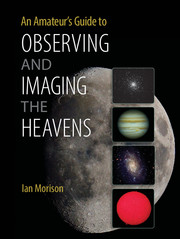Book contents
- Frontmatter
- Dedication
- Contents
- Preface
- Acknowledgements
- Prologue A Tale of Two Scopes
- 1 Telescope and Observing Fundamentals
- 2 Refractors
- 3 Binoculars and Spotting Scopes
- 4 The Newtonian Telescope and Its Derivatives
- 5 The Cassegrain Telescope and Its Derivatives
- 6 Telescope Maintenance, Collimation and Star Testing
- 7 Telescope Accessories
- 8 Telescope Mounts
- 9 The Art of Visual Observing
- 10 Visual Observations of the Moon and Planets
- 11 Imaging the Moon and Planets
- 12 Observing and Imaging the Sun
- 13 Observing and Imaging with an Astro-Video Camera
- 14 DSLR Deep-Sky Imaging
- 15 Imaging with Cooled CCD Cameras
- 16 Auto-Guiding and Drift Scan Alignment
- 17 Spectral Studies
- 18 Improving and Enhancing Images in Photoshop
- Index
- Plate Section
6 - Telescope Maintenance, Collimation and Star Testing
Published online by Cambridge University Press: 05 June 2014
- Frontmatter
- Dedication
- Contents
- Preface
- Acknowledgements
- Prologue A Tale of Two Scopes
- 1 Telescope and Observing Fundamentals
- 2 Refractors
- 3 Binoculars and Spotting Scopes
- 4 The Newtonian Telescope and Its Derivatives
- 5 The Cassegrain Telescope and Its Derivatives
- 6 Telescope Maintenance, Collimation and Star Testing
- 7 Telescope Accessories
- 8 Telescope Mounts
- 9 The Art of Visual Observing
- 10 Visual Observations of the Moon and Planets
- 11 Imaging the Moon and Planets
- 12 Observing and Imaging the Sun
- 13 Observing and Imaging with an Astro-Video Camera
- 14 DSLR Deep-Sky Imaging
- 15 Imaging with Cooled CCD Cameras
- 16 Auto-Guiding and Drift Scan Alignment
- 17 Spectral Studies
- 18 Improving and Enhancing Images in Photoshop
- Index
- Plate Section
Summary
Collimation is the process that is used to align the optics of a telescope in order to provide images of the highest possible quality, whilst star testing is a way of testing the optics of a telescope. These two topics are combined in this chapter because star testing can show that a telescope needs collimation and also provides the way of making the final collimation adjustments. Star testing can also highlight other optical problems and in some cases allow them to be corrected but, be warned, it is exceedingly sensitive and very few telescopes, though providing excellent images, will give perfect star tests. In more complex optical designs, star testing might well give somewhat odd results and will not be a good indicator of the telescope’s optical performance.
Refracting telescopes rarely, if ever, need any maintenance but, after a year or two, the primary mirror of a Newtonian or the corrector plate of a Schmidt-Cassegrain may need cleaning. This is not too frightening a prospect, provided that it is done carefully, so let me first describe how best to do it. If the mirror surface is in really bad condition, with the reflecting surface beginning to erode, this might be the time to have it re-coated. If so, it is worth having one of the new multi-coated, high-reflectivity coatings applied, such as the Hi-Lux coatings provided by Orion Optics in the UK. Not only should such coatings last for many years, the overall contrast of the telescope will be significantly improved.
- Type
- Chapter
- Information
- An Amateur's Guide to Observing and Imaging the Heavens , pp. 86 - 99Publisher: Cambridge University PressPrint publication year: 2014



